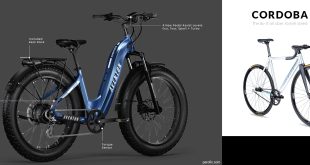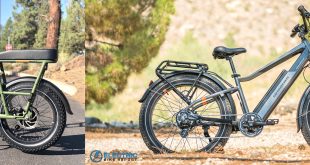Can Rad Bike Fat Tire Handle Anything?
Rad Bikes have made a name for themselves with their fat-tire e-bikes, and it’s no exaggeration to say these machines can take you almost anywhere. From sandy beaches to snowy paths, muddy trails, and rugged city streets, the fat tires aren’t just a visual statement—they’re the core of their versatility. Let’s break down why Rad Bike fat tires are considered nearly unstoppable.
Technical Anatomy: Why Fat Tires Matter
The Rad Bike Fat Tire models, like the RadRover, come with 4-inch-wide tires. Here’s what makes them handle just about any surface:
- Extra Surface Area: Wide tires distribute weight more evenly, reducing sinking in sand or snow.
- Enhanced Traction: The deep treads grip loose or slippery terrain, preventing unwanted slides.
- Shock Absorption: Fat tires naturally absorb bumps, reducing strain on your arms and back while riding on rocky trails or uneven streets.
- Low PSI Riding: Operating at 15–20 PSI allows the tire to conform to terrain irregularities for smoother handling.
Personal Trail Test
Last winter, I decided to test my RadRover on a mix of urban and off-road conditions. Snow-covered paths? Handled effortlessly. Muddy trail loops after heavy rain? No slipping, just solid control. Even navigating gravel roads felt surprisingly stable. The fat tires provided a forgiving ride, making it easy to maintain balance and speed without overexertion.
Motor, Battery, and Frame Synergy
The fat tires alone don’t make the RadRover unstoppable; it’s the combination of key components:
- 750W Rear Hub Motor: Provides ample torque to climb hills or push through tough terrain.
- 48V Lithium-Ion Battery: Offers 25–45 miles of pedal-assist range, depending on terrain and effort.
- Durable Frame: The steel or aluminum frame supports larger tires and the additional weight, keeping the ride stable.
With this combination, Rad Bike fat tires can confidently handle urban commuting, weekend trail adventures, or beach excursions.
Practical Tips for Maximum Handling
Tip #1: Adjust tire pressure based on terrain—lower for soft surfaces, higher for smooth roads.
Tip #2: Regularly clean your tires and drivetrain to maintain traction and longevity.
Tip #3: Use pedal-assist for steep climbs or tricky terrain to reduce strain and conserve battery.
Tip #4: Check the brakes before heavy off-road use. Hydraulic disc brakes are reliable, but mud and debris can reduce efficiency.
Frequently Asked Questions
1. Can Rad Bike fat tires handle sand and snow?
Yes. The 4-inch-wide tires distribute weight and maintain traction on soft or slippery surfaces, making sandy beaches and snowy paths navigable.
2. Are fat tires slower on paved roads?

They have slightly higher rolling resistance compared to thinner tires, but the difference is negligible with pedal assist. For city commuting, the trade-off is comfort and stability.
3. How durable are fat tires?
Rad Bike fat tires are highly durable. Puncture-resistant layers and thick rubber construction reduce the risk of flats, even on rough terrain.
4. Can beginners ride on trails with fat tires?
Absolutely. Fat tires provide forgiveness on uneven terrain, making them ideal for riders learning off-road techniques.
5. How do fat tires affect battery life?
Wider tires require more energy to propel, especially on soft terrain. Using pedal assist conserves battery while still enjoying powerful traction.
Trends and Sustainability
E-bikes with fat tires are becoming more than adventure toys—they’re tools for sustainable urban transport. Their ability to traverse mixed surfaces allows riders to skip car trips on weekends or even commute through unpaved routes. Cities are increasingly supporting e-bike infrastructure, and fat tires open opportunities for less-than-perfect urban paths. Eco-conscious riders can enjoy versatility without relying on fossil fuels.
Future Trends and Innovations
Looking ahead, we can expect fat tire e-bikes to feature lighter, stronger materials for even better handling, more efficient battery systems, and smart electronics that adapt motor output to terrain automatically. Integrated GPS and terrain-sensing features may also become standard, making fat tire bikes smarter and more versatile.
Buying and Maintenance Advice
- Assess Terrain: Choose fat tires if you frequently encounter sand, snow, gravel, or trails. Urban-only riders may not need them.
- Check Motor and Battery: Ensure your motor provides enough torque for steep or loose terrain and that the battery capacity fits your range needs.
- Regular Maintenance: Clean tires, lubricate the chain, and check brake efficiency after off-road use.
- Test Ride: Feel the handling, comfort, and stability before committing to your purchase.
Conclusion
So, can Rad Bike fat tires handle anything? Almost. Between the 4-inch-wide tires, powerful motors, and supportive frames, these bikes conquer snow, sand, mud, gravel, and city streets alike. Add proper maintenance, smart battery usage, and some pedal assist, and you’ve got a versatile e-bike that balances adventure with sustainable transportation. For beginners and experienced riders alike, Rad Bike fat tires redefine what an e-bike can tackle.
 Electric Bike & Bicycle Repair Hub Master DIY electric and traditional bike repairs with practical tips and trusted product recommendations.
Electric Bike & Bicycle Repair Hub Master DIY electric and traditional bike repairs with practical tips and trusted product recommendations.



